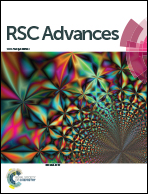Tailoring elastomeric properties of waterborne polyurethane by incorporation of polymethyl methacrylate with nanostructural heterogeneity
Abstract
Although modification of waterborne polyurethane (WPU) using acrylic polymer (PA) is a widespread approach to prepare PU materials with high performance, not much attention has been paid to the variation of elastomeric property of the obtained WPUA hybrid materials with the presence of PA component. In this work, a series of aliphatic polycarbonate (PCDL) based waterborne polyurethane and polymethyl methacrylate (PMMA) hybrid dispersions (WPUA) were fabricated via a two-step procedure. The heterogeneous structure of hybrid dispersions was investigated, showing that the dispersed particles possess a nano-sized core–shell morphology. The hydrogen-bond interactions in hard domains are weakened by incorporation of PMMA component. The nanostructural heterogeneity in the dried films was determined by using MDSC, AFM, SAXS, DMA and linear rheology techniques. The tensile strength and strain-hardening modulus increase and the elongation at break decreases with increasing PMMA content. Plastic deformation of PMMA domains in WPUA only results in a loss in recoverable elasticity at low strains. With an optimized content of PMMA, the WPUA2 sample shows sharp yielding behavior while maintaining high extensibility and good recoverable elasticity at large strains. The improvement in elastomeric properties and other physical properties by incorporating PMMA component can expand the applications of waterborne PUs as environment-friendly thermoplastic elastomers.


 Please wait while we load your content...
Please wait while we load your content...